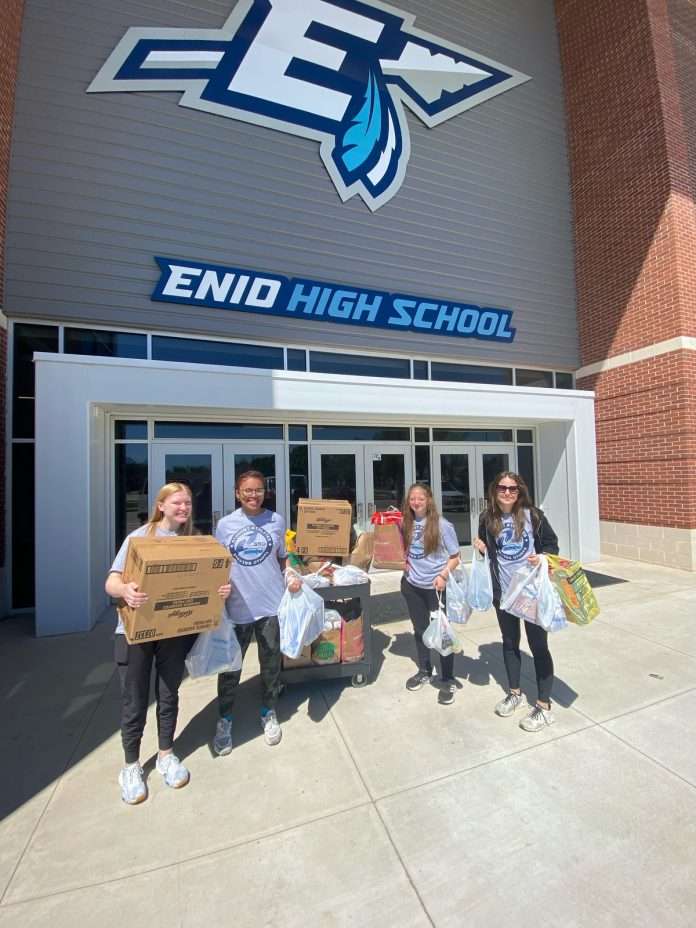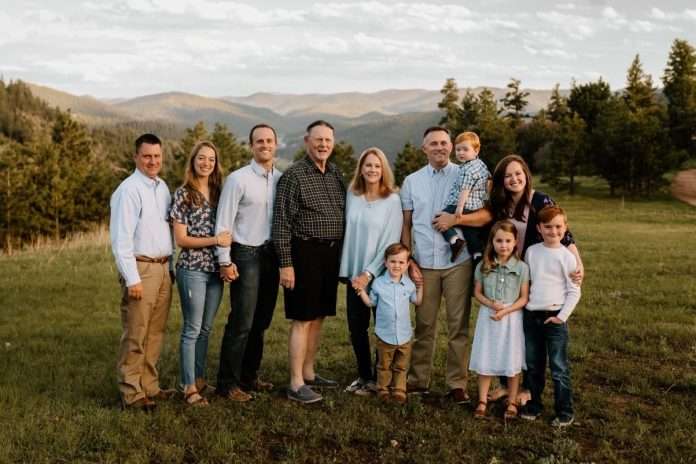Keeping Up With Your Prostate Health Can Save Your Life
Get to know the simple ways that you can stay a step ahead of this dangerous cancer. Dr. Casey Cochran, DO, provides some useful information.

What purpose does the prostate serve?
It’s out of sight and usually out of mind, but the prostate – the walnut-sized gland that sits between the bladder and the penis, in front of the rectum, in men – cannot be ignored. It produces a fluid that is important in male fertility, as well as another fluid that lubricates the spinal cord. In addition, urine passes through the urethra, which goes through the prostate. If there is an issue with the prostate, such as prostate cancer, it can affect a man’s health, self-image and lifestyle.
How common is prostate cancer?
Prostate cancer is one of the most common forms of cancer among men. According to the Centers for Disease Control and Prevention, 13 out of every 100 men will get prostate cancer in their lifetime, and on average three of those men will die because of it.
How do you get screened for prostate cancer?
Even if you aren’t experiencing symptoms, all men 55 to 69 years old should talk to their doctor about getting routinely screened. Men who are 70 and older generally can skip routine screenings.
Fortunately, prostate cancer can be detected early with simple testing, including a rectal exam by the physician or a prostate-specific antigen (PSA) test. This simple blood test is commonly used to measure the blood level of a protein (called PSA) that is created in the prostate. The test can be performed in the office by a primary care doctor or urologist. It’s recommended to get tested annually.

Is there a genetic component to prostate cancer?
African American men are more likely to be diagnosed with prostate cancer and twice as likely to die from it. Prostate cancer can also be triggered by genetic factors such as family health history. If one or more immediate family members have had prostate cancer, you should mention it to your doctor.
What are some symptoms of prostate cancer?
• Difficulty urinating
• Frequent urination
• Blood in urine or semen
• Painful or burning urination
• Trouble emptying bladder
• Painful ejaculation
• Pain in back, hips and/or pelvis
If you experience any of these symptoms, contact your physician immediately.
Are there ways to lower your risk of developing prostate cancer?
There are proven strategies and behaviors to lessen your risk of cancer in general. They include:
- Lower alcohol consumption (or stop altogether). Drinking alcohol increases your risk of several types of cancer. It also impacts your sleep, mental health, skin, energy levels and weight. Men are recommended to keep consumption to two drinks daily (one for women).
- Get moving. Around 40% of all cancers can be associated with being overweight or obese. Regular physical activity can improve your brain health, strengthen bones and muscles, improve your sleep, lower stress and even lower blood pressure, to name a few benefits.
- Protect yourself from the sun. Ultraviolet rays from the sun can be extremely harmful to your skin. Wear SPF, protective clothing/gear (hat, sleeves, sunglasses) and stay out of the direct sun when you can.
- Eat colorfully. In general, eating healthily allows your body to function at its best potential. Limiting sugar intake has a number of benefits. It reduces the risk of disease, lowers risk of depression and aids in weight management, and more. Fill your plate with brightly colored fruits and vegetables, and steer clear from overly processed snacks.
“Early detection of prostate cancer can lead to successful treatment,” added Dr. Cochran. “It’s best to detect prostate cancer through screening when there are no symptoms or when they are at an early stage, when it is highly treatable.”
You can take steps to stay healthy and live a long life for yourself and your family. We’re here to help!
Contact your doctor for a consultation or, for assistance finding a doctor who’s right for you, call 580-599-6391.

For language assistance, disability accommodations and the nondiscrimination notice, visit our website
Chicken Caesar Pasta Salad
Summer is coming, and I really dislike heating up the house with my oven and other appliances, so I have decided to make some lighter fare this year. So I told the Hubs to be prepared for lots of salads and sandwiches for the warmer months. And I started with one of my favorites...Chicken Caesar Pasta Salad. This salad pulls in the fresh green Romaine lettuce with cooked pasta and chicken with the distinct flavor of a good Caesar dressing. It is a fantastic entrée, but could easily be served as a side dish as well.
Now, I made this salad the other evening for our dinner, and we had leftovers FOR DAYS!! I mean, this salad makes ALOT! So be prepared....or you may want to cut the recipe in half. However, it would be the perfect salad to take along to a picnic or get together where there will be many to feed.
I will say to make sure you use a Caesar dressing that would be a good stand-alone dressing. My favorite is Brianna's Caesar Dressing. (not advertising at all, but if anyone has the contact....) I fell in love with this dressing when the bakery was open and it was the dressing for The Nook's Caesar Salad. It's got a fantastic balance of garlic and parmesan flavor with black pepper. I highly recommend it! But, any creamy Caesar dressing will work, but it does need to be creamy so it will "hang on" to the different pieces of the salad. If you use an oil-based Caesar, the oil and seasoning will simply sink to the bottom of the bowl, removing the opportunity for that garlicy-parmesan flavor in every bite.
This salad is also very versatile as well. I have a cousin who made the same salad with chopped up breaded chicken tenders and cooked mini cheese tortellini. You could also add 1/2 cup or so of real bacon bits, or 1/2 cup of a vegetable like sliced cucumber moons, sliced fresh mushrooms or fully cooked and cooled peas. The possibilities are as endless as your imagination!
So try it and see what you think. Happy cooking!!!
CHICKEN CEASAR PASTA SALAD
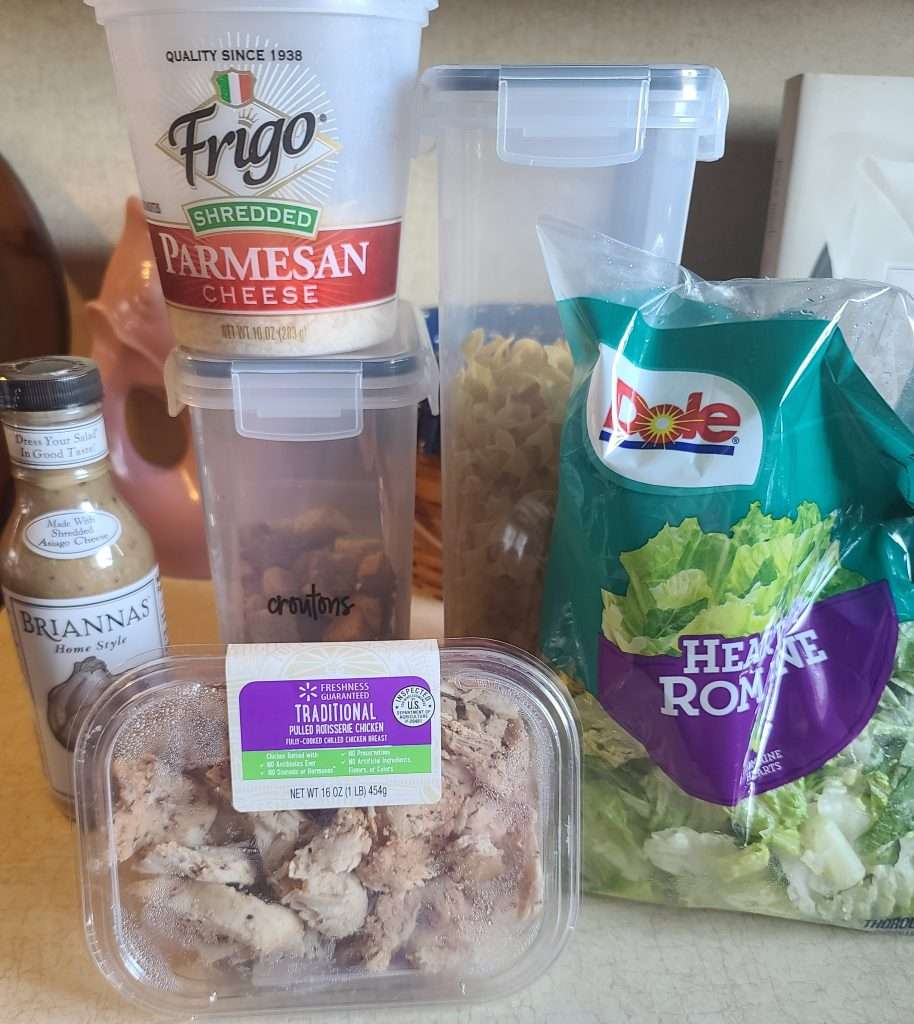
Ingredients
• 8 ounces bow tie pasta
• 3 hearts of Romaine, chopped (I used pre-chopped hearts of Romaine)
• 1 rotisserie chicken, shredded*
• 5 ounce bag Caesar croutons
• 12 ounces creamy Caesar dressing (my favorite is Brianna's)
• 6 ounces parmesan cheese, shredded
*I purchased pre-shredded rotisserie chicken from my local grocery store.
Instructions
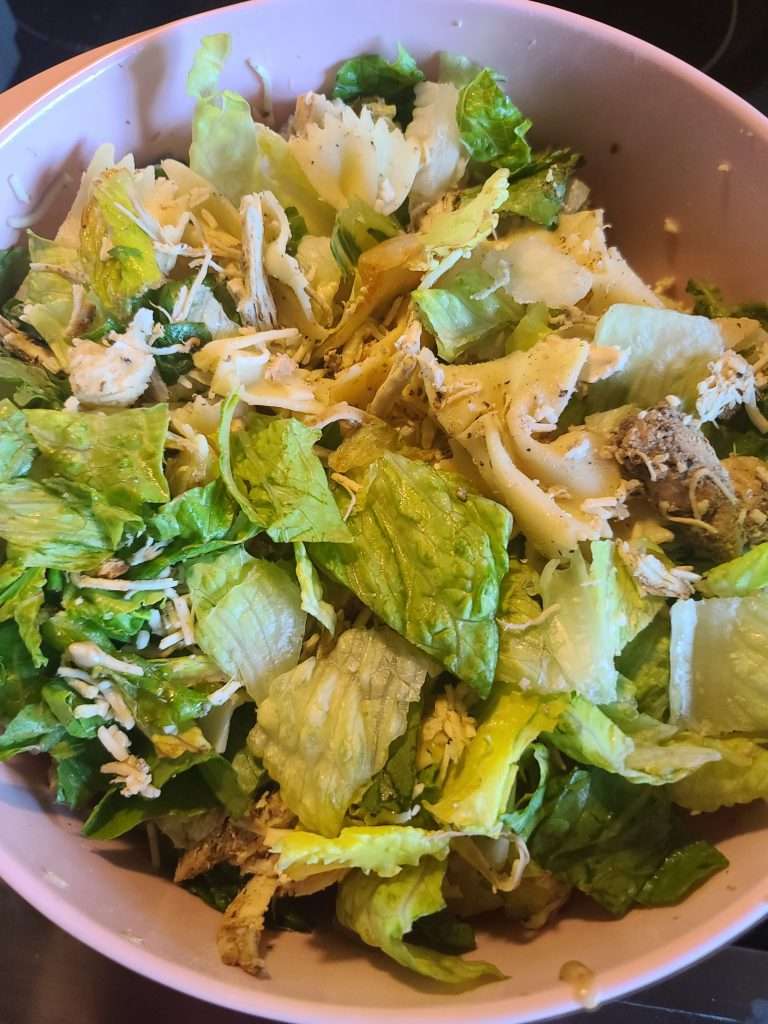
1)Bring a large pot of water to a boil over high heat. Add pasta and cook according to package directions. Drain pasta, rinse with cold water, and set aside in a large bowl and chill.
2) Cut hearts of Romaine into 1 inch pieces and shred rotisserie chicken then add to the large bowl with pasta.
3) Pour dressing over salad and toss to fully coat noodles and lettuce.
4) Sprinkle with parmesan cheese and bacon and top with croutons. Toss to combine.
Class of 2023
The theme for Enid monthly articles for this year was “The OBA Commitment.” And throughout the past year, we’ve had several articles to try and convey people’s expressions of commitment to the OBA mission. As the new Communications Director, who stepped into the year halfway through, I can say that this year’s Class of 2023 embodies our theme well.
Now we want to take a moment to recognize this senior class’s achievements. We will have five Valedictorians, two Salutatorians, eight students graduating with honors and a National Merit Scholar. That’s over half the class. One student passed all nine of their AP exams. We have three students attending college as athletes after successfully leading their teams this year. This year’s seniors have one of the highest collective ACT scores in OBA history and already acquired hundreds of hours of college credits. We had three students win the Oklahoma Arts Excellence Award and one write and direct their own play. They’ve excelled as members of Gaslight teens, church youth group leaders, travel sports team members, and one already sworn into the Air National Guard.
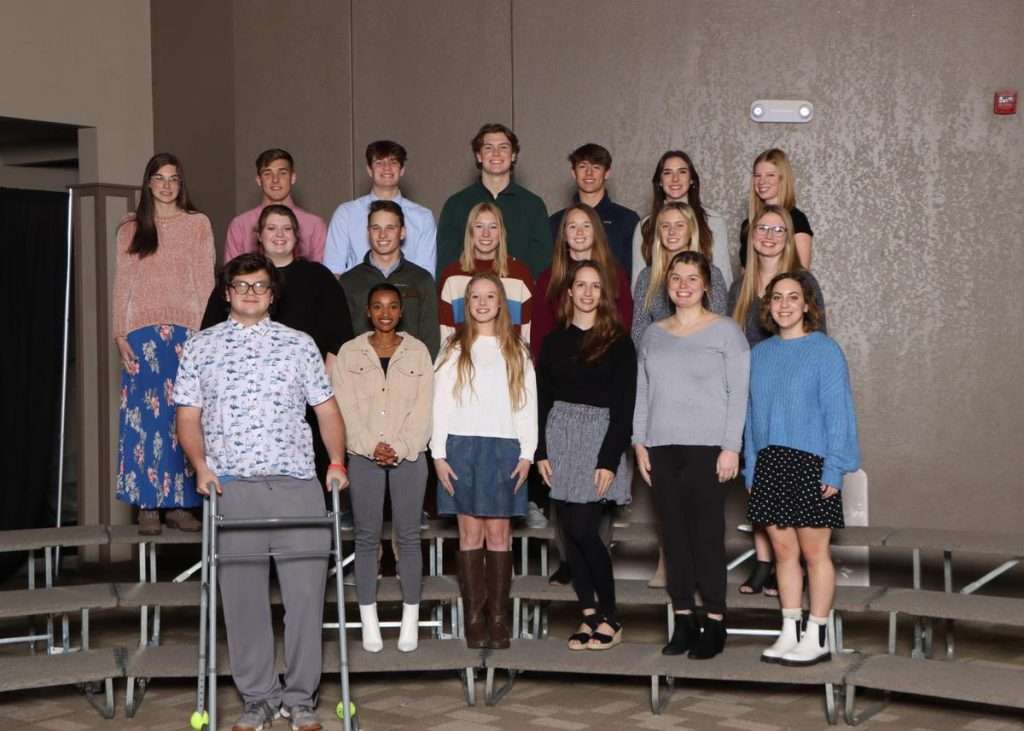
While these students are standouts in terms of academic excellence, they shine in other ways. When I asked some of OBA’s faculty how they would describe this year’s senior class, they said things like: relational, loyal, and unified. These are all traits that they can take with them into their future endeavors. The one trait that stood out among the rest was that they are “zealous in their choice to serve.” These seniors have learned ‘to do hard better’ because of overcoming challenges like emergency online learning as freshmen and an irregular learning environment of social distancing and quarantines as sophomores. They will continue to serve others upon the completion of their time at OBA.
We’ve highlighted a few individual class members here and there over the past year, but this entire class deserves to be celebrated. They are not only smart, high achieving, and excellent in academics, but they are also kind and wonderful leaders. We look forward to seeing the Class of 2023 grow into great contributors and become ambassadors for OBA and our kingdom mission. Congratulations, Class of 2023! We are so proud of you.
Super Food or Super Weed?
Low in fat, cholesterol, sodium, and carbohydrates, high in potassium, protein, vitamin A (seven times more beta carotene than carrots!), vitamin C, and Omega-3 fatty acids, and containing eight essential amino acids and antioxidant flavonoids and polysaccharides used in therapy for Parkinson’s, Alzheimer’s, and type 2 diabetes, this superfood has it all. Additionally, lab tests show that a compound of this plant helps kill liver cancer cells and plant seed extracts are active against brain and lung cancer cells. Best of all, this plant tastes yummy with a slightly citrusy, salty, with a peppery kick and a juicy crunchy texture. You can eat the leaves, stems, flowers, and seeds, either raw or cooked.
Common Purslane has been consumed for thousands of years in the Mediterranean, Mid East, Asia, and by the indigenous North Americans both fresh, cooked, and juiced or decocted as medicines. In spite of all the beneficial health uses and time-worn testing, common purslane has been called “a noxious weed” by the USDA.

Common Purslane (Portulaca oleracea) also known as hogweed, pigweed and pusley, is an annual succulent that looks like a tiny jade plant with alternating leaf clusters at stem joints. Each fleshy, flat green leaf is oval to spoon-shaped and broadest near the rounded tip. The half-inch wide small yellow flowers that bloom midsummer through early fall, have five notched petals. The flowers blossom at the stem joints, with just a single bloom opening at a time.
Purslane is propagated from seed, stem cuttings, divisions of root systems, and transplanting them. One plant can produce over 50,000 seeds. Seeds remain viable in the soil for several decades. Decades!! Purslane seeds can be sown outside after the last frost by sprinkling them onto moist soil and pressing them in lightly. As a cutting, each piece of stem can create a new plant. To propagate a stem cutting, cut a six-inch long stem and remove the leaves from the bottom half. Plant the stem in soil with half the stem underground in an area with bright, indirect light and keep the soil moist.
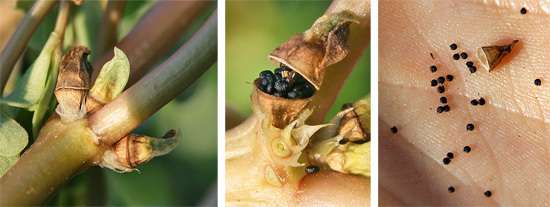
Purslane loves full sun and our Oklahoma heat. A good place to plant them is next to walls or fences which reflect heat. Plus, they are not picky about soil. As a weed, these plants can be found easily growing in sidewalk cracks and on the side of the road. But if you are growing purslane for food, these will grow larger, juicier plants in loamy, porous soil without much water.
Harvest mature leaves about 50 days after you plant the seeds. Cut a single stem at a time or most of the plant. Leave about 2 inches above the soil and it will regrow. Oddly enough, the time of day that you harvest makes a difference in the flavor. Plants harvested in the morning taste tart and the evening cuttings have a sweeter flavor. Stems can be stored in the refrigerator for up to a week in a plastic bag.
Purslane can be dried and used as a dried herb or like cornstarch thickener. Some cooks serve purslane steamed like spinach. A refreshing way to enjoy purslane is in a salad.
So, you decide – Super Food or Super Weed?
Shed Hunting – A Family Affair
Welcome to Summer, Okie friends! Hope y’all we able to bag a big ole’ Tom turkey this Spring. Don’t fish? Whatever shall you do between Turkey season and Dove season? While I like to fish and predator hunt, if those things aren’t for you but you are itchin’ to get outside try shed hunting!
If you aren’t familiar, shed hunting is exactly what it describes: “hunting” for sheds of antlers of deer. Typically, Whitetail bucks shed their antlers between December and April, making spring or early summer the perfect opportunity to get back into the woods.
Why do deer shed their antlers you ask? Hormonal changes, including a significant drop in testosterone levels which causes the antlers to weaken and eventually fall off.
Where/how to search? If you are like me, I like searching every square inch of my property or hunting lease. Not only do I love the search itself, it beats the heck out of a treadmill. My daughter is 8 years old and also loves wearing her cowboy boots crashing up and down the creek. She’ll find little “sea shells” and pretty crystallized rocks and whatnot to put in her fanny pack. She LOVES when she finds the deer sheds before I do (don’t tell her I pretend to not see them). Occasionally we’ll take a picnic and some water and sit on a falling log under a shade tree and just enjoy nature. While confined to our house I’d be lying if I said my kids didn’t enjoy their iphones, I’m blessed in the fact they all love sports and the outdoors (well, the last is a stretch for my 14 y/o, but still).
One caveat: Unless you are going in March or early April, I’d suggest loading up on the bug spray. In 8 years I don’t think I’ve seen my daughter as upset as she was when we found an embedded tick on her. Snakes and other creepy crawlers are starting to move around, so I prefer a knee high pair of Muck boots as well.
Get outside. God has given us a beautiful Earth for us to explore and appreciate nature and the like. Who knows, you might work off some of those Lenox or Lottaburgers without even thinking about it. See ya next month!
Students Serving Others
On Saturday April 29th, more than 200 Enid High Student Athletes and dozens of coaches fanned out across the community to help local non-profits, community groups and individuals in the first “Students Serving Others Day.” The idea of a specific day to help the community came from Enid High Athletic Director Billy Tipps. “We did a similar day at a previous school I was at, so I’ve been wanting to do something similar here for the last three years, but had not had the time to get it organized. But this year, with the help of Assistant Athletic Director Lyndsay Watts, we were finally able to get it done, and it was awesome!” said Tipps.

Each team could choose its own project and did not have any specific requirement, other than it had to be service-oriented and helping someone else. Some teams came up with their own projects with ideas from the players or coaches, and for some, the projects were suggested by the athletic department. “The baseball team found their own project, which was helping an individual move from one house to another, that had no other way, which I thought was cool,” said Tipps, “and other groups did all kinds of different things, from helping out at the ESPCA, to a food drive for Loaves & Fishes, to volunteering at the Cherokee Strip Regional Heritage Center.”
Vickie Grantz, the Executive Director of the ESPCA, was delighted to have the athletes volunteer. “This is the first time we have had a group of minors volunteer like this, and it was a great experience for us and the animals. They were very professional, worked hard and wore the animals out. The Cross Country and Pom teams helped us get our food pantry organized, pulled weeds in our yard and socialized the dogs and the cats. We’d love to have any of the kids back, and anyone else that would like to volunteer,” said Grantz.
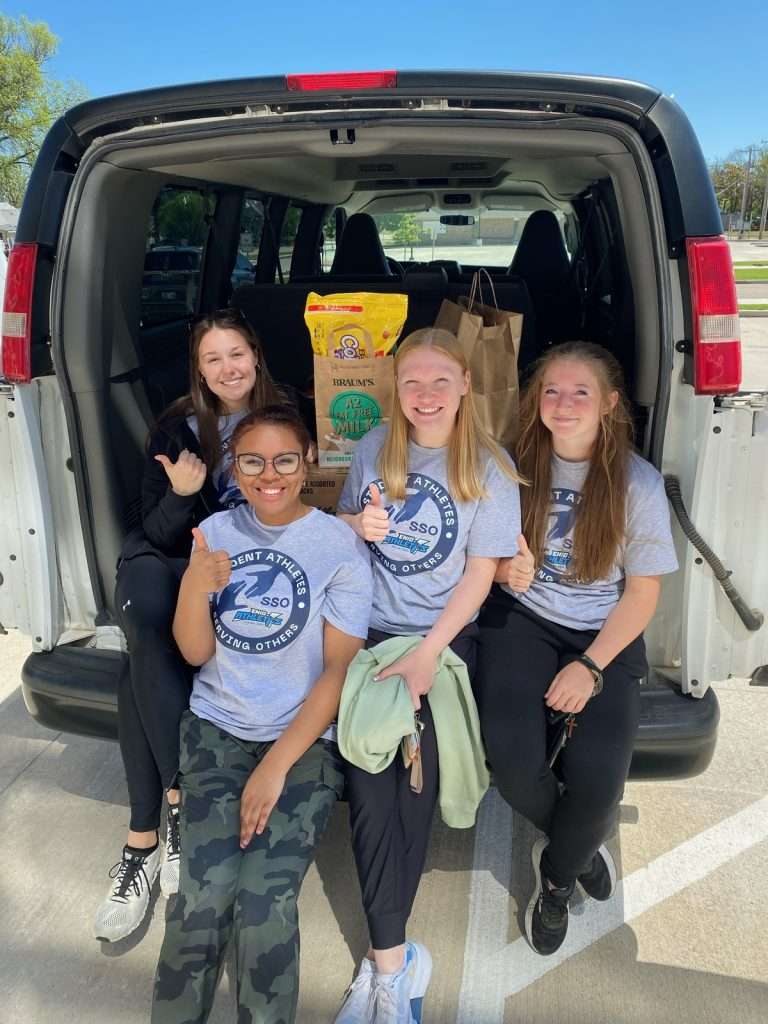
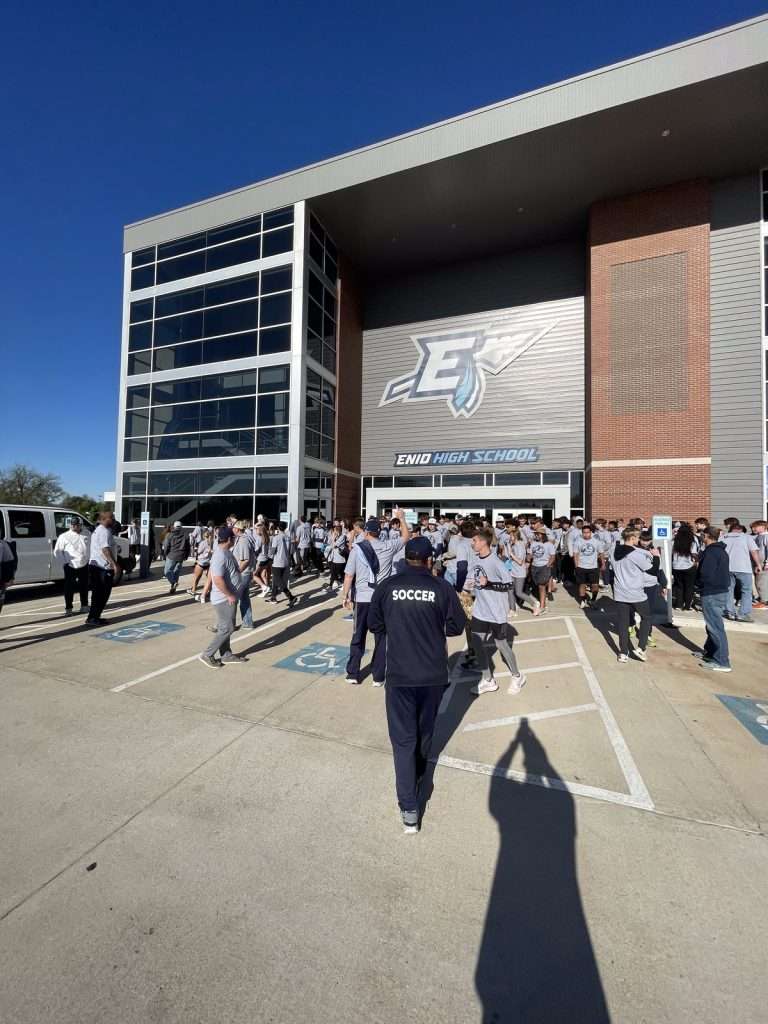
Assistant A.D. Watts said “This was just an amazing way for us to show our appreciation for the community for giving is this beautiful gym and the other facilities and support they have blessed us with. We just wanted to serve them in some way.”
The day went so well, Watts and Tipps believe the event will continue to grow and want to try and do a similar event in the fall and the spring next year. “I just can’t say enough how much we appreciate the coaches and the students giving their extra time to this. We know that they are inundated with things on their plate, so for them to come out on a Saturday morning, with great attitudes and seeing how much they got from giving back was really, really cool,” said Tipps.
Best Friends Day
Hey y’all, and welcome to the June Teen Scene article in Enid Monthly. Congrats on making it halfway through 2023!! June 8th is National Best Friend Day so this month I’m going to tell you all about my best friends and what I look for in friends. Let’s go!!
My first best friend was Mallie. We’ve known each other since pre-k but became really close in the 5th grade. She is one of the funniest girls I know and never fails to put a smile on my face. Even though she can be a little slow at times I love her so much and couldn’t ask for anyone better. During cross country season Mallie started being friends with a girl named Maritza, they instantly clicked. Since I was always with Mallie I started to get to know Maritza and we also became close and now our Trio is unbreakable. One of my favorite memories with them is when we had our first sleepover together, we stayed up till 6 in the morning just talking.
This year I took Speech and Debate and I didn’t really have any friends or know anyone in that class. I started talking to this girl named Aspen and we instantly became friends. We started hanging out more at tournaments and talking all the time during class. She had a love for running so she asked me about the track team and I gave her a little push to join and after she did we became besties. At every track meet it would always be me and her together unless one of us was running. She even got me to teach her how to play tennis!! One of my favorite memories with Aspen is whenever we took funny pictures in the 5th hour using the panoramic setting on our camera and made each other look so dumb.

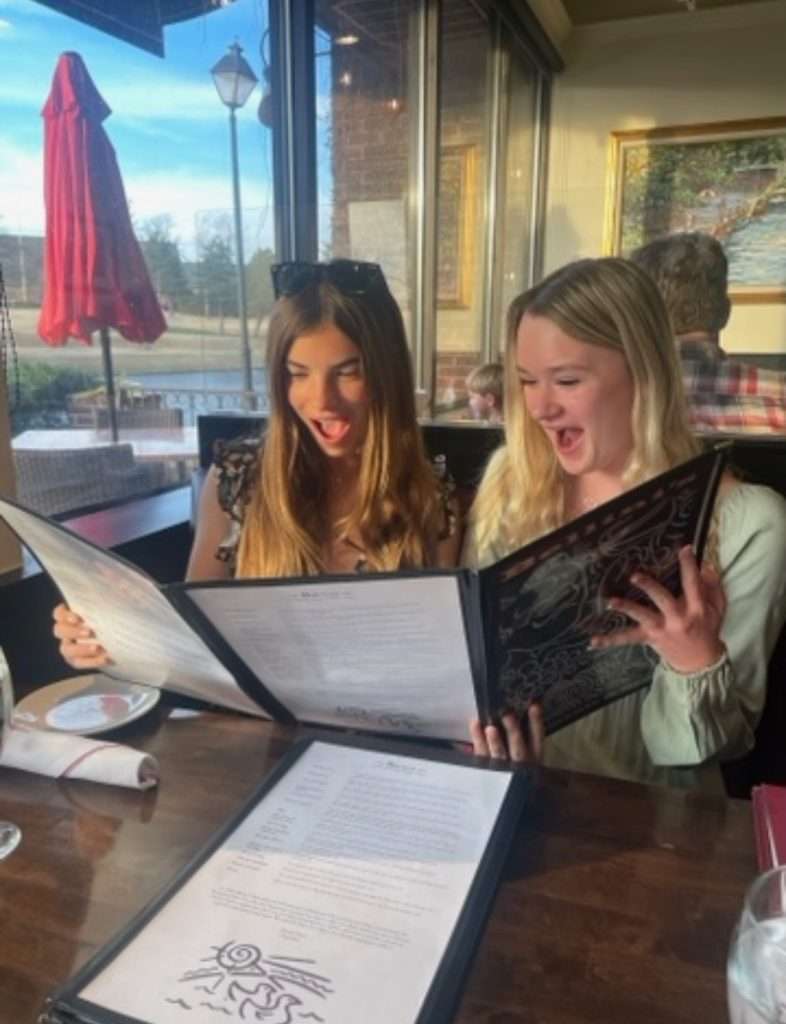
The main quality I look for when choosing friends is being hilarious. If you are not funny then I don’t know how we could be friends!! Me and my friends are always laughing at some point which can really bring you up if you’re feeling down on yourself. I think a lot more teens need to find better friends for themselves because you ARE your friends. If they are doing something they shouldn’t be doing then it’s going to put a bad look on YOU. This occurs a lot in high school friend groups and I wish some people would try to better themselves by finding new friends.
Being a good friend to others is also very important because you never know what they could be going through. Even if it’s simple it’s always important to let someone know you are there for them when they think no one else is. If you see someone having a bad day don’t be rude, just mind your own business or ask them what’s wrong. When I notice one of my best friends is down on themselves I always try to make them laugh and cheer them up so maybe you should try it too!! Thank you for reading this month’s article, I hope you enjoyed it!! I would love to hear about your best friends so email me at tweensceneenid@gmail.com also if you have any comment, questions or ideas for upcoming articles let me know there too! I hope you all have a wonderful June and a Happy Father’s Day. Bye for now!!
Judge John Michael – Local Legend
John Michael was born in Ada to a preacher at the Christian church. In 3rd grade he moved to Cherokee, then to Pond Creek in 11th grade. For college, John attended Phillips University and East Central before graduating with his bachelor’s degree from Oklahoma State. Desiring to be a lawyer, he attended the Oklahoma University School of Law, graduating with a juris doctorate in 1971. John was in private practice in Medford before running for Associate District Judge in Grant County. In 1985 he was appointed District Judge in Garfield County where he remained until his retirement in 2005. He was so well respected that he faced only one contested election in over 30 years on the bench.
1n 1999 he helped start the Garfield County Specialty/Drug Court which has seen hundreds of successful graduates get their lives back on track and become excellent contributors to society. He continues to volunteer his time as the Drug Court Judge in retirement and takes great pleasure in its success.
Judy Helberg, former Specialty/Drug Court Coordinator said “I could write forever on what Judge Michael has done for Specialty Drug Court. He always has the hard job of keeping clients in line, and it’s not always easy. He listens, is patient, and tries to understand all sides to a situation. Clients finishing the program often say he was always fair and respected him to the fullest. Judge Michael has always looked at Specialty Court as something God has called him to do, and helping people change their lives by getting employment, education and in some cases reuniting families that have been affected by addiction is all the satisfaction he needs for the job.”
The current Specialty Court Coordinator, Kara Savage, said “Judge Michael has had an immense impact this community over the last 20 years, one graduate at a time. He is passionate about the success of each participant and remains persistent so that each one of them end up a productive citizen of society.”
Judge Michael lives with his wife Cheri, with whom he has one adult son, Johnie. He also has two other sons, Seth and Drew from a previous marriage and 4 grandchildren.
For Judge Michael’s honorable service to the community, he is a true “Local Legend.”
Local Legends is Proudly Presented by Humphrey and Guarantee Abstract Company!

Best of Enid WINNERS!
Congratulations to everyone nominated, finalists and winners that were announced at the SOLD OUT Best of Enid Awards Show on June 1. We couldn’t have done it without the more than 30,000 votes, great Gold, Silver, Table and Raffle sponsors, and Award Show attendees! Without further ado – the finalists and winners are below! Winners for each category are in BOLD! Congratulations!
Best Accountant
William Hann- Hann Plummer
Kelly Mendel – CSCO
Dee Plummer – Hann Plummer
Best Apartments
Esplanade at Stonebridge Village
Hunters Hills Apartments
Tuscana Apartments

Best Attorney
Ben Ezzell
Dalen McVay
Russell Singleton
Best Auto Repair/Service
Four J’s Tire Service
Grand Garage Automotive & Towing
Speed Tech Automotive
Best Bank/Credit Union
Bank of Kremlin
Stride Bank
Tinker Federal Credit Union
Best Bakery
Donna Jean’s Bakery
Jumbo Bakery
Katy’s Pantry
Best Bar
Callahan’s Pub & Grille
Liquor in the Axe
Settler’s Brewing Co.
Best BBQ
Blaze’s BBQ
Swadley’s Bar-B-Q
Turkey Creek Smokin’ BBQ & Cajun
Best Boutique
Bee Jeweled Boutique
The Boho Teepee
Okie Babe Boutique
Best Breakfast
Boomerang Diner
Café Volare
Wee Too
Best Burger
Flamingo Lounge
Lenox Drive-In
Lotta Burger
Best Cannabis Dispensary
Mother’s Joy Dispensary
Natural Remedies
Heatseekers Dispensary

Best Coffee Shop
Coffee Inclination
Davinci’s Coffeehouse and Gelateria
Five 80 Coffeehouse
Best Car Dealership
Northcutt Chevrolet-Buick
Northcutt Toyota
Stuart Nissan of Enid
Best Childcare Provider
Kiddie Cove Home Daycare
Kinder Connection
Summerhill Children’s House
Best Children’s Party
Enid Axe
Leonardo’s Children’s Museum and Adventure Quest
Nicole’s Gymnastic Academy
Best Chiropractor
Dr. John Conaway
Dr. Erin Jenkins
Dr. Arnold Kenyon
Best Dental Care
Dr. Daulton Roberts – TLC Dental
Dr. John Thomas – Enid Family Dental
Dr. Jarrod Lack – TLC Dental
Best Electrician
Byrum Electric Co.
Brody Ronistal Electric
Dense Mechanical/Comfort Solutions
Best Entertainment
Enid Axe
Oakwood Bowl
Stride Bank Center
Best Eye Doctor
Dr. Justin Funk – Premier Eyecare of Enid
Dr. Brian Shewey – Enid Eye, Inc.
Dr. Heath Stotts – Vision Source
Best Family Medicine
Dr. Emily Cooper
Dr. Renah Gibson
Andrew Ward, APRN
Best Financial Planner
Will Gungoll – Edward Jones
Keith Holsten – K/H Financial
Jenna Rosine – Edward Jones
Best Fitness/Gym
Denny Price Family YMCA
Planet Fitness
Rosebud’s Aerial Yoga Studio
Best Florist
Enid Floral & Gifts
Huffman Floral
Uptown Florist
Best Funeral Home
Anderson-Burris Funeral Home
Brown Cummings Funeral Home
Ladusau Evans Funeral Home & Crematory

Best Hair Salon
Bloom Hair Studio
Bluejay’s Barbershop & Beauty
Twisted Scissors Hair Studio
Best Heating & Air
Dennis Plumbing, Heat & Air
Dense Mechanical/Comfort Solutions
Slater Mechanical
Best Home Maintenance/Remodeling
Matthew Compton Remodeling
Le Roux Contracting
Stephens Construction
Best Insurance Agency
Jeff Eaton State Farm
Enid Insurance Agency
Mike Stuber – Farmers
Best Jewelry Store
Ediger’s Diamonds
Jackson Diamond Jewelers
Zales
Best Lawn Care
Blake’s Lawn Care
Enid Lawn Co.
Galopa Services
Best Liquor Store
Proof Wine & Spirits
Rock Island Liquor and Wine
The Wine Press
Best Local Restaurant
Callahan’s Pub & Grille
Napoli’s Italian Restaurant
Tokyo Japanese Hibachi Grill & Sushi Bar
Best Massage
Dia Metcalf
Amanda Peters
Tonya’s Massage & Wellness Spa
Best Beauty Care/Spa
Blossom Beauty Bar
The Med Spa at Enid Live Well
Salon De’fy
Best Mexican Restaurant
El Patio
Mama Tita’s
Sandy’s Tacos

Best Orthodontist
Orthodontic Solutions
Rose Rock Orthodontics
Schuessler Orthodontics
Best Pet Grooming
Groom Closet Pet Center
Lollie’s Grooming
Unleashed – Pet Grooming Salon

Best Pharmacy
Family Pharmacy
Rick’s Pharmacy
Scheffe Prescription Shop
Best Photographer
Jesse Heddleson Photography
Jennifer Johnson – Mug Shots Photography
Wess & Jolene Grey Portraits
Best Pizza
A Fuego Pizza
Godfather’s Pizza
Hideaway Pizza
Best Plumbing
Dennis Plumbing
Dense Mechanical/Comfort Solutions
J.A. Benge Co.
Best Realtor
Lori Dick – Nicholas Residential Real Estate
Casi Nichols – E-Towne Realty
Torrie Vann – Coldwell Banker Realty III
Best Roofing
Eagle Heritage Roofing
Fine Roofing & Remodeling
Vargas Roofing
Best Senior Living
Burgandy Place
Golden Oaks Village
Greenbrier Village
Best Tattoo Parlor
Apothika Tattoo
Blood Brothers Tattoo
Omocke Ink
Best Thrift Store
Hope Outreach Thrift Store
Park Avenue Thrift
Return Engagement
Best Veterinarian
Dr. Kristy Krueger-Krisle
Dr. Taylor Shrum – Wheatland Animal Clinic
Dr. Joyce Yauk – The Cat Clinic
Best Wings
Buffalo Wild Wings
Callahan’s Pub & Grille
Wingstop












